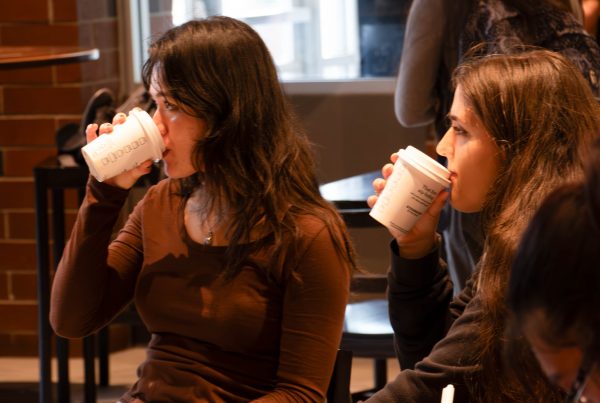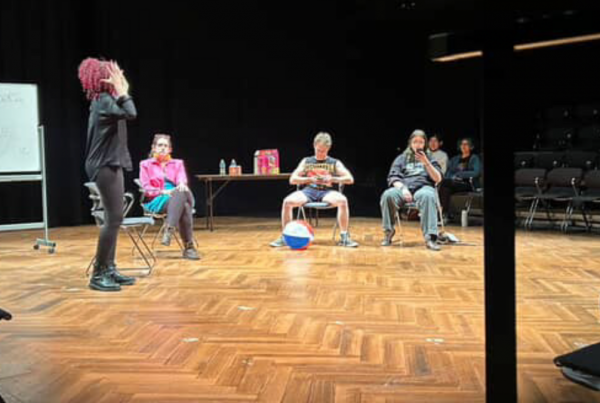Whether it’s dated stereotypes or jazz standards, some things always come back around. In the theater world, “Guys and Dolls” has yet to go out of fashion, including at the University of Nevada, Reno.
The musical, which premiered in 1950, will see 57 productions worldwide this month alone, according to Music Theatre International, the company that sells the rights. One of them opens tonight, March 7 at 7:30 p.m. in the Redfield Proscenium Theatre here on campus, running for two weekends with $5 student tickets. But it’s also a fresh occasion for what some have called the show’s poorly-aged sensibilities to reach new viewers.
Eden Jeser, a student performer in the ensemble, said they’ve learned a lot from the vaudeville-style comedy and golden age jazz featured in the show. But the creative team has had to confront the material’s dismissive attitude towards women in the process.
“There’s this musical number called ‘Guys and Dolls,’ and it’s like, ‘if you see a man doing this for a woman, he’s, like, under her spell,’” Jeser said. “It’s kind of the idea behind the show…women are referred to as dolls. They’re not necessarily seen as people, they’re kind of a commodity.”
Even Adam Cates, the show’s director, said he initially struggled to connect with the musical because of it.
“But what I do,” Cates explained, “I sort of pare it down to ‘what is the show actually about?’ And what it’s about is relationships. What it’s about is people trying to find love and understanding and a decent crap game, so I totally understand all of those things. Once you get down to who these characters are, what they want and how they’re just trying to navigate life, it becomes something that’s much more relatable to anybody, I think.”
Cates added that the text will always exist in the time it was written, making the facts of the ‘50s and American culture at the time inescapable – but that doesn’t mean the creative team and audience can’t step back and ask questions.
Jeser thinks audiences can take in the show’s attitude about gender, and be critical about it.
“I would say that if you look beyond that, you can see the comedy in that,” Jeser said, “and you can see that we’re not trying to portray that as what’s correct, we’re just trying to portray that as what was true at the time.”
Elysia Martinez, who plays the straight-laced, determined Sarah Brown, loves the show and argues that her character is essentially a feminist by 1950s standards. She sees the misogyny on display in the material as an opportunity for audiences to reexamine parts of those norms that are still in place.
“I hope it brings up the discussion of recognizing…that we do still treat women in this way, and just to acknowledge that we should not,” Martinez said.
The real draw to the show, Martinez said, is the music, and how many stars have carried on the tradition of performing it. Cates agrees.
“The songs are iconic,” Cates said. “When Frank Loesser [the show’s composer] wrote these songs, they instantly became top-40 hits. They’re still in the jazz repertoire. And the music is timeless, it’s just part of our American repertoire.”
Audiences will have the opportunity to hear it live with a 10-piece band when the show is performed. It’ll feature skilled student performers that Aren Long, the musical’s orchestral director, called the university’s “Avengers of jazz.”
International Women’s Day coincides with the second night of the show’s run, March 8.
Peregrine Hart can be reached via email at peregrineh@unr.edu or on Instagram @pintofperegrine.
AUDIO ARTICLE TRANSCRIPT:
00:00 (Voiceover): There’s something you should know about UNR’s spring musical.
(Music): The average unmarried female, basically insecure…
(Voiceover): UNR’s production of “Guys and Dolls” opens on Friday, March 7 at 7:30 p.m. in the Redfield Proscenium Theatre.
(Music): With psychosomatic symptoms, difficult to endure…
(VO): But the original Broadway show premiered in 1950, and be forewarned… it sure can sound like it.
(Nathan Show Dialogue): A guy without a doll… if a guy does not have a doll, who will holler at him? A doll is a necessi-TEE.
00:34 (Sky Show Dialogue): I am not putting the rap on dolls, I’m just saying a guy should have ‘em around when he wants ‘em. Nathan, figuring weight for age, all dolls are the same.
(VO): And if you missed the memo there, dolls are “women.”
(Music): Yes sir! When you see a guy reach for stars in the sky, you can bet that he’s doing it for some doll…
(VO): All the same, you’ve probably heard music from “Guys and Dolls” somewhere, and it remains a wildly popular piece of musical theatre history. This March alone, UNR’s will be one of 57 productions happening worldwide, according to the company that sells the rights.
01:09 (VO): It all starts with Nathan Detroit, a chronic gambler, trying to find a spot for his secret crap game. He’s of course hiding this from his fiance of 14 years, Adelaide.
(Adelaide Show Dialogue): I can do without anything so long as you’re not running that crap game again!
(Nathan Show Dialogue): The crap game? What an absurd thought!
01:27 (VO): In her day job, Adelaide dances for a crowd of raunchy male onlookers. But what she really wants is to get married – in fact, she’s convinced that the longer she doesn’t, the more physically ill she’ll get.
(Music): The female remaining single, just in the legal sense … shows a neurotic tendency, see note…
(VO): Meanwhile, Nathan’s buddy Sky Masterson bets him that he can get a missionary named Sarah to fall in love with him. Sarah is a tight-laced, anti-gambling and anti-drinking Christian who parades through the streets of New York with her mission band.
02:05 (Music): Put down the bottle and we’ll say no more. Follow, follow the fold (before you take another swallow)…
(VO): In one particularly memorable scene, Sky takes Sarah to Havana, where he orders her a cocktail without telling her there’s alcohol in it. Well, he does tell her there’s Bacardi in it.
02:32 (Sarah Show Dialogue): Does a Bacardi have alcohol in it?
(Sky Show Dialogue): Oh, only enough to act as a preservative!
(VO): So how will this material go over with a college audience after over seven decades of cultural change? Some things might raise a few eyebrows.
(ADAM CATES): Well, 1950 was a different time, there were different values going on in the country, different expectations. A thing about Guys and Dolls, it’s done so often that I think audiences are comfortable with it, but we have to remember that this writing is 75 years old.
03:07 (VO): That’s Adam Cates. He’s worked in the theatre industry for 30 years now, and he’s directing the show.
(CATES): We can’t really look at it through a contemporary lens of how we view gender roles without remembering that it’s always going to exist in the time it was written. And so what we’ve tried to do with this production is honor that, and look at it as a golden age musical.
03:33 (CATES): This is my first time working with it, and I had a little bit of trouble finding my way in at first, I think, because it looks at gender roles so traditionally. But what I do… I sort of pare it down to what is the show actually about and what it’s about is relationships, what it’s about is people trying to find love and understanding and a decent craps game, so I totally understand all of those things, and so once you get down to who these characters are, what they want and how they’re just trying to navigate life, it becomes something that’s much more relatable to anybody, I think.
04:13 (VO): Some of the show’s performers even argue that Guys and Dolls is more subversive than it might seem. Here’s Eden Jeser; they sing and dance in the ensemble as part of Sarah’s mission band.
(EDEN JESER): There’s a number called ‘Guys and Dolls’ and it’s like, if you see a man doing this for a women, he’s like, under her spell, and like it’s kind of the idea behind the show is like, women are referred to as dolls. They’re not necessarily seen as people, they’re kind of a commodity.
04:35 (Music): When you spot a John waiting out in the rain, chances are he’s insane as only a John can be for a Jane … if you meet a gent payin’ all kinds of rent for a flat that could flatten the Taj Mahal…
(JESER): But I would say that if you look beyond that, you can see the comedy in that, and that we’re not trying to present that as what was correct, but what was true at the time. They definitely pick characters who aren’t necessarily the 1950s ideal. So Miss Adelaide works at the hotbox, she does burlesque, so that’s not necessarily something that everyone was doing in the 1950s, or something that wasn’t necessarily seen as positive. Sarah’s a missionary, so she’s kind of the complete opposite side of the spectrum […] And I find it very interesting that we picked this show to do right when the new administration’s coming into office, just because the 1950s seems to be their ideal as to what America should look like. And I think this shows that women in the 1950s weren’t just housewives and doing all these things that I think a lot of conservative mindsets think that they were doing. It’s more so that there’s nuance between all these people. Like yes, Adelaide wants traditional, but her lifestyle isn’t traditional.
05:43 (VO): Even Sarah, the teetotaling missionary, can be read progressively – according to Elysia Martinez, who plays her in the show.
(ELYSIA MARTINEZ): I fell in love with her doing research for the audition. She is a feminist of this time period, she’s a sergeant at the Save a Soul Mission, so she’s high up in her role at her workplace … and I think she’s very complex, and she is very vulnerable throughout the show. And we talked a lot about her role as a feminist in this world, same with Adelaide, too, they both are very strong women, and I love this show, and I love her.
(VO): And where misogyny comes out in the material, Martinez says she thinks it can be a productive way for audiences to start asking themselves some questions.
06:33 (MARTINEZ): I hope it brings up the discussion of recognizing that sometimes we do treat women … not sometimes … we do still treat women this way, and just to acknowledge that we should not, and just respect for everyone in general.
(VO): And something else that was true at the time – the show’s music left a huge mark on pop culture, even more than the show itself.
07:06 (CATES): It’s a part of the American tradition, the songs are iconic – when Frank Loesser wrote these songs they instantly became top 40 hits, they’re still in the jazz repertoire … and the music is just … it’s timeless.
(Music): I’ll know when my love comes along, I won’t take a chance…
07:31 (MARTINEZ): The music, the music, I mean … and the stars that have been in this show before like Frank Sinatra and Marlon Brando and Nathan Lane, Philippa Soo, all of these big names that have done this show and the iconic music that Frank Sinatra sang, taken out of this piece of the show.
(Music): That at last I come home safe and sound….
08:05 (VO): Orchestra director Aren Long said they spent ages going through the show’s score and rearranging it to fit the 10-piece ensemble that will be playing live on stage for every single number. You’ve been hearing them in the background as the rehearsal pianist.
(LONG): You know, every single song is such a hit. There’s such a legacy of artists who have performed these songs.
(Music): Until then, I shall wait. Until then, I’ll be strong … for I’ll know when my love comes along…
08:39 (LONG): You know, it’s interesting from the lens of the music, the type of jazz that we’re experiencing with the show is so functional, and what I mean by that is that Frank Sinatra style: it’s glossy, it’s tight, it’s fast, it’s fun. That type of music doesn’t necessarily exist all the time, especially in jazz nowadays. It’s developed so much that there’s so much more modern twists that you could take it. This is really truly golden age jazz, and so it’s really fun to come listen to. It might surprise people just how vintage it sounds.
09:10 (VO): Even acting has changed since then, so you could think of Guys and Dolls as something performers do for the same reason they do Shakespeare: to learn something new – especially an old, exaggerated style of comedy that informs a lot of what we still see today, called vaudeville.
(JESER): I think it teaches actors a lot. A lot of us have never done vaudeville acting, a lot of people are trying to learn how to do that style, more so … the music’s very classic … if you learn how to do this style of acting, it’s going to help you in every other production, because it just develops your skills as an actor. A lot of actors are very good at realism, but not necessarily good at things they’ve never done before.
(CATES): The writing… Abe Burrows, who wrote the book, was like a radio and vaudeville personality, and so the jokes are very vaudevillian. It’s hilarious, the timing of the scenes and these characters. Comedy is comedy, and the vaudevillians defined it, you know, what American comedy is, and if we trust the text, it will still land today.
10:10 (VO): Guys and Dolls will also be the biggest musical UNR has put on in a while, and the biggest it’s done since it started offering a degree in musical theatre five years ago. CJ Greer, the musical director for the show, says it’s a big forward step.
(CJ GREER): For the theatre and dance department, we really want to strike a balance for students who are majoring in musical theatre of knowing and being exposed to golden age musicals as well as contemporary musicals. And so that’s the first time we’ve given this from a pedagogical perspective. And that’s really important for not only the students’ growth, it’s also just usually such a community pleaser that I’m really excited for audiences to come and see what we’re doing here at UNR. Because I think this music theater program is growing, and I think this will be a stepping stone in that direction for people to really see what’s happening here.
11:00 (VO): And who knows? You might just get to see a Sagebrush cameo.
(Music, the flapping of newspapers sometimes audible through the lyrics): What’s in the daily news? I’ll tell you what’s in the daily news! Story about a guy who bought his wife a small ruby with what otherwise would’ve been his union dues. THAT’s what’s in the daily news…
(VO): For the Nevada Sagebrush, I’m Peregrine Hart.








